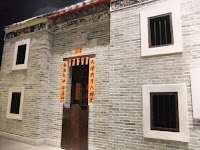Hong Kong Heritage Museum - The Hakkas and Fishing Origin
15 June 2012
It has been more than 10 years that I haven't been to the Hong Kong Heritage Museum. Today, a Picasso exhibition brought me back. Hmm, a Spanish artist associating with the Chinese heritage. It's a special event of the French May. It drew a lot of people to the museum, though a bit remote. People, family speaking different languages crowded at the venue. Picasso's paintings shown were across his different periods. Many photos of him and friends were also shown.

During the reign of Yongzheng and Qianlong of Qing Dynasty (18th century), people were encouraged to utilise wasteland for farming. A big demographic shift of residents in the south moved to Hong Kong. They were name 'Hakka' (guest) as opposite to the Punti (local originals). As the Hakka resettled in Hong Kong at a later stage, they could only build their home in the New Territorities, at poorer farmland. Hakka people denote 'hard work and determination'. Hakka women, in particular, were diligent workers with high stimina. They worked in the fields and undertook all heavy labour work.




The plough (top right) was carried by a buffalo to loosen the soil. The sieve of buffalo manure (top left) was used to fertilise the soil. After harvest, rice plants were threshed by blashing against a wooden frame. The tub is for holding the grain ears and the screen is to prevent the grain ears from sprinkling out of the tub. Lastly, the rice-hulling mill is for husking rice.
 Early settlers conducted their business in the markets. They brought their produce there and purchased their daily necessities. Traditonal markets were found in Tai Po, Sheung Shui and Yuen Long. They were founded by important clans. With the decline of agriculture in 1970s, all these vanished but pieces of history.
Early settlers conducted their business in the markets. They brought their produce there and purchased their daily necessities. Traditonal markets were found in Tai Po, Sheung Shui and Yuen Long. They were founded by important clans. With the decline of agriculture in 1970s, all these vanished but pieces of history.
 |
| HK Heritage Museum - Hakka Women |

Hong Kong Heritage Museum is unique in providing the history of Hong Kong, featuring Hakka (Guest family) migration, as a fishing village, the traditional Cantonese opera as the integral parts of Hong Kong's heritage, history and culture.
During the reign of Yongzheng and Qianlong of Qing Dynasty (18th century), people were encouraged to utilise wasteland for farming. A big demographic shift of residents in the south moved to Hong Kong. They were name 'Hakka' (guest) as opposite to the Punti (local originals). As the Hakka resettled in Hong Kong at a later stage, they could only build their home in the New Territorities, at poorer farmland. Hakka people denote 'hard work and determination'. Hakka women, in particular, were diligent workers with high stimina. They worked in the fields and undertook all heavy labour work.

Houses, tools for making living, different shops and a model of a clan are exhibited. Audiences can imagine the hard life and the united spirit of the Hakkas.



 Early settlers conducted their business in the markets. They brought their produce there and purchased their daily necessities. Traditonal markets were found in Tai Po, Sheung Shui and Yuen Long. They were founded by important clans. With the decline of agriculture in 1970s, all these vanished but pieces of history.
Early settlers conducted their business in the markets. They brought their produce there and purchased their daily necessities. Traditonal markets were found in Tai Po, Sheung Shui and Yuen Long. They were founded by important clans. With the decline of agriculture in 1970s, all these vanished but pieces of history. |
| Kun Lung Wai - by Tang clan in Fanling |
Some of the clan villages are preserved. Still five walled villages and six villages of the Tang Clan can be viewed.
Another heritage of Hong Kong is fishing, vanishing......Short documentary film replayed in the museum to let one envisage the old days. Life was harsh. Fishing families clustered in bad environment or crowded on fishing boat spending their daily life.
Wanna learn about the entertainment history? Click here. Or browse national grade treasure, antique displayed at the Heritage Museum.
Equally interesting and worth browsing is the rich collection of Chinese art. Don't miss it.









Comments